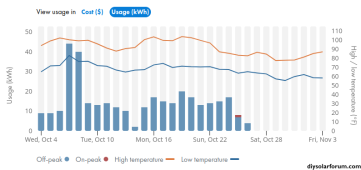ksmithaz1
Solar / EV Junkie
2 cents:
I'd get three (3) 240v/50a inverters in parallel such as the EG4 or Sol-Ark Units, purely for demand/redudancy. The EG4 units currently do not support staying on when one is down. If the Sol-Ark's do that is a consideration verify that part of the operation. By the time your project gets going this may change. You'll want 90 KWH of batteries, and around 20KW of Solar panels. I would design a small-ish outbuilding to hold all the solar/battery/electrical and a 10KW generator. Run 2/0 feed wires in conduit up to a 150A "sub"-panel on the house. Build high-efficiency as you have outlined. Leave room /plumb for another 60KWH of batteries in your outbuilding ( 5 equipment racks ), and another AIO (These beasts are pretty big). Get your propane but feed it to the generator. I'd run a pellet stove(s) inside for emergency / aesthetic heating Maybe in the L/R and Bonus Room, or perhaps LR and garage) or a wood fireplace if it gets too cold for a modern heat pump.
You may need to bump your solar panels for battery fill considerations, cover the roof figure out a ground-mount location for some extra as needed. I'd go all-electric appliances, including the dryer and an electric traditional 50Gal tank style HWH, and an induction range. As far as the Low vs High Frequency my pair of EG4's seem to work just fine starting a crappy Goodman 4T HVAC with a Magic Start. It worked without the Magic Start but really dimmed the lights, so HF should be fine if you engineer for it from the get go. The well pump will be the trickiest but I don't think it pulls as much on start as my HVAC did when it was 120 outside this July and no magic start. You might look into a smart electrical panel at the house.
Don't over-think it. You can also build it lower and scale it, just plumb for the extra. You could start with 2 inverters, and 60K of batteries maybe 10K of panels, and see how it goes. You can add panels if the batteries are not getting charged on lower production days, add a rack of batteries if your overnites start kicking on the generator too often.
Sounds fun, good luck. I finally kicked the grid habit a week ago with an additional 30KWH of batteries (see my sig) But I do HAVE the grid if I need it.

I'd get three (3) 240v/50a inverters in parallel such as the EG4 or Sol-Ark Units, purely for demand/redudancy. The EG4 units currently do not support staying on when one is down. If the Sol-Ark's do that is a consideration verify that part of the operation. By the time your project gets going this may change. You'll want 90 KWH of batteries, and around 20KW of Solar panels. I would design a small-ish outbuilding to hold all the solar/battery/electrical and a 10KW generator. Run 2/0 feed wires in conduit up to a 150A "sub"-panel on the house. Build high-efficiency as you have outlined. Leave room /plumb for another 60KWH of batteries in your outbuilding ( 5 equipment racks ), and another AIO (These beasts are pretty big). Get your propane but feed it to the generator. I'd run a pellet stove(s) inside for emergency / aesthetic heating Maybe in the L/R and Bonus Room, or perhaps LR and garage) or a wood fireplace if it gets too cold for a modern heat pump.
You may need to bump your solar panels for battery fill considerations, cover the roof figure out a ground-mount location for some extra as needed. I'd go all-electric appliances, including the dryer and an electric traditional 50Gal tank style HWH, and an induction range. As far as the Low vs High Frequency my pair of EG4's seem to work just fine starting a crappy Goodman 4T HVAC with a Magic Start. It worked without the Magic Start but really dimmed the lights, so HF should be fine if you engineer for it from the get go. The well pump will be the trickiest but I don't think it pulls as much on start as my HVAC did when it was 120 outside this July and no magic start. You might look into a smart electrical panel at the house.
Don't over-think it. You can also build it lower and scale it, just plumb for the extra. You could start with 2 inverters, and 60K of batteries maybe 10K of panels, and see how it goes. You can add panels if the batteries are not getting charged on lower production days, add a rack of batteries if your overnites start kicking on the generator too often.
Sounds fun, good luck. I finally kicked the grid habit a week ago with an additional 30KWH of batteries (see my sig) But I do HAVE the grid if I need it.




